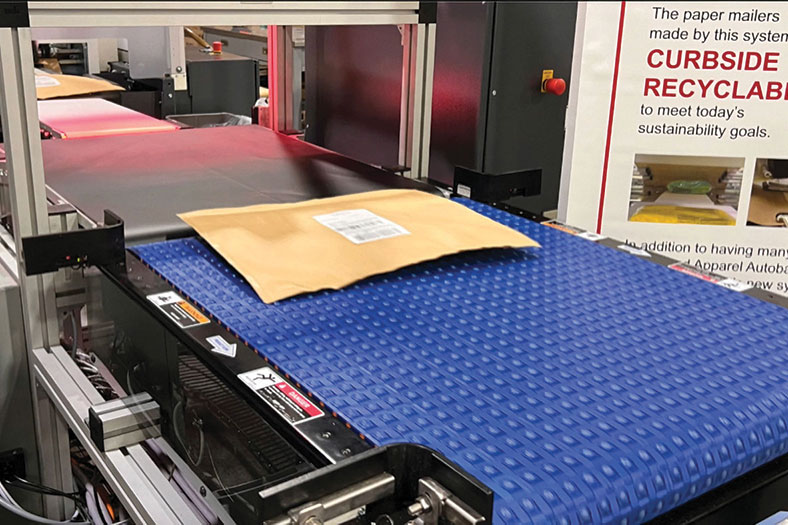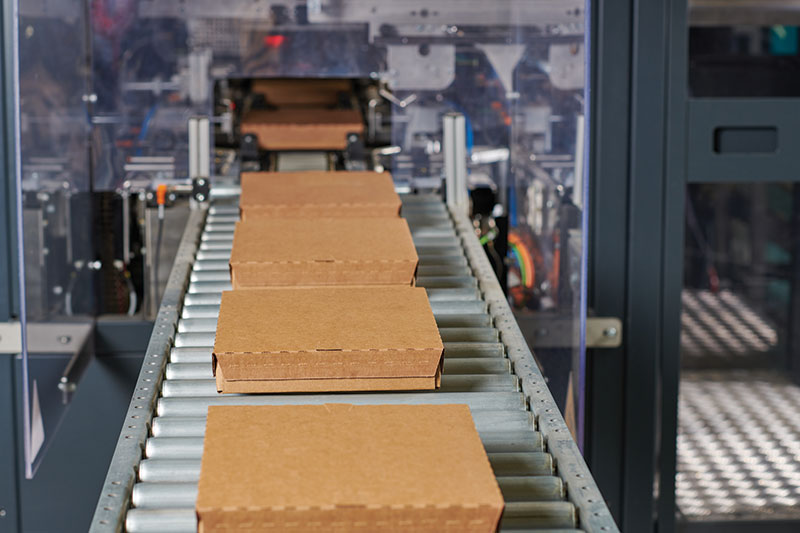Sustainable packaging equipment and systems comes on strong
Packaging equipment and systems continue to address sustainability, from the growing popularity of systems that right-size corrugated cartons on demand to autobaggers that use kraft paper stock rather than poly. Companies are also looking to ensure high, sustained throughput and improve the unpacking experience.
The pandemic threw so many supply chain obstacles at companies that the march toward sustainable packaging may have been thrown off pace. Now that supply chains are regaining balance, the sustainable focus is back and as sharp as ever, with advances like autobagging machines that use recyclable paper stock and greater demand for automated packaging systems that can right-size cartons on demand.
For several years now, shippers have paid closer attention to “right-sizing” cartons for e-commerce fulfillment to reduce freight costs, and other channels have sought efficiencies such as greater use of reusable packaging. But during the depths of the pandemic when everyone was scrambling to obtain inventory, sustainability wasn’t top of mind, says Alicemarie Geoffrion, president of packaging for DHL Supply Chain, which offers packaging capabilities as part of its logistics services.
“If I look at requests from customers and bids that are coming out, sustainability is definitely high on the agenda,” says Geoffrion. “It’s back up there as a leading goal, and so we as an organization continue to invest in sustainability from a packaging perspective.”
Multiple packaging systems and methods support sustainability, adds Geoffrion, including automated lines that right-size cartons, minimizing scrap, leveraging more reusable packages and containers, or efficient kitting and fulfillment of store promotional materials. Eye-catching retail displays can even be shipped with the products that go in them, minimizing freight. In short, there’s not one packaging approach to sustainability, but many.
Another underlying driver with packaging is building a better customer experience. This need is supported by innovations such as autobaggers that can generate curbside recyclable paper-based bags, or automated packaging solutions that allow for branding on cartons or that automatically insert personalized cards or offers. The pandemic may have distracted some from sustainable packaging initiatives for a short period of time, but it’s a sure bet that getting packages created and shipped with less waste, and in a way that impresses customers, are goals that are here to stay.
“The packaging projects we see as an integrator have multiple drivers, including reducing the labor requirement, increasing throughput and increasing accuracy, all of which you get with automation. But another big trend we see is being able to customize orders,” says Ed Romaine, vice president of marketing and business development at Conveyco Technologies.
“There are a number of our customers that when they send out an order—it’s pretty. It might have a thank you card inserted on top or coupons aimed at that customer. The ability to customize packaging is revenue-generating for the shipper and adds value by presenting the end customer with a personalized experience.”

Carton right sizing
Automated systems that create a corrugated shipping box to match the size of the item or items being shipped continue to see further deployments because they promise benefits like labor reduction, high throughput and elimination of unnecessary void space from using larger-than-needed standard sized boxes.
“Having the ability to right-size the package helps to reduce waste and offer weight and space savings,” says GianCarlo Bobbio, protective equipment and automation marketing director at Sealed Air Corp., which offers packaging automation. “Also, it eliminates the need for void fill, which translates into less material needed for packing the product.”
Reducing package size by 1 inch or a few ounces has the potential to reduce dimensional or actual package weight by 1 pound, according to Sealed Air. Reducing package dimension or weight by 1 pound could save up to $2.00 per package in last-mile delivery costs.
For right-sized packaging automation systems to work their magic, solutions typically incorporate scanning technology within the line to capture item dimensions, comparing captured actual dimensions to DIM (dimensional) data in back-end systems.
“To do that at scale you almost need to have a combination of real data compared with master data,” says Rod Gallaway, CEO of Packsize International, a provider of on-demand carton right-sizing automation. “That is where we see the most success.”
Users typically look for a reduction of costs with carton right-sizing equipment, which comes from minimizing freight costs and eliminating the need to staff manual pack out stations, allowing companies to reallocate labor. Sustainability goals are increasingly important to many brands and shippers, agrees Gallaway, but only if the same equipment cuts cost.
“Cost reduction is still No. 1 with these systems, that’s for sure, and the speed and reliability of the system that delivers the labor savings is also highly important, but ESG [environmental, social, governance] factors have moved in priority among our customer base,” says Gallaway.
On-demand carton creation results in cartons that form tightly around the product or products being shipped. This not only cuts material waste, says Gallaway, the tight fit helps with the integrity of the carton, which helps reduce damages, and ultimately, helps the customer experience.
“When items are perfectly packaged in a right-sized carton, it makes for a great experience to open up the carton,” says Gallaway. “You don’t have to think about what to do with the waste. You don’t have a bunch of dunnage to gather up. It just makes for a better experience, and the consumer is more likely to buy from that supplier again.”

Users of package right-sizing systems, however, are also after speed. Today, adds Gallaway, package right-sizing automation systems can top more than 1,000 packages per hour, outputting one about every 3.5 seconds.
“What we find is that there are many operations struggling to achieve the throughput they need,” Gallaway says. “There are multiple benefits to what we offer, but ultimately customers are after high throughput and reliability in their e-commerce packaging operations.”
Package right-sizing solutions that address the needs of high-volume, e-commerce fulfillment are a trend, says Sean Webb, director of automated packaging solutions for Sparck Technologies. For example, he says, sites using Sparck’s high-speed Everest solution can achieve up to 1,100 boxes an hour. Sparck estimates that one system, depending on what came before in terms of manual pack-out, can eliminate eight to 16 packing stations.
“We work with our customers on achieving high, sustained rates, so they get the throughput they need out of the system,” says Webb. “The marketplace is still becoming aware of all that you can achieve with autoboxing, and how it benefits their fulfillment process.”
Autobaggers embrace paper
Automated bagging machines are the other main equipment type helping operations package efficiently, rather than using manual packing and pre-made bags. Trends with autobaggers include the use of paper mailer stock that is curbside recyclable, as well as robotic solutions that automate the scanning and induction of items into autobaggers.
Reducing labor requirements is a core driver for autobagging, says Greg Berguig, vice president of sales and marketing for PAC Machinery, which offers autobagging solutions, but it goes beyond cost savings on a per-pack basis versus manual bagging. This issue, says Berguig, is that with order volumes high, and a high degree of difficulty in securing enough labor, operations are looking to put in 10 or 20 machines, not just one, because autobaggers remove the concern of being able to find enough staff for manual pack out operations.
“Autobagging gives you a per-pack cost savings, but the bigger issue really is that by automating, you don’t have to worry about being able to find enough staff. And you can get more packs out the door in less space.”
Berguig points out that autobaggers can now also make use of curbside recyclable paper material, as well as bags made from recycled plastic. “The nice thing about paper is that when it shows up at a consumer’s door, they have the simplicity of curbside recycling,” he says. “You just mix it in with the paper.”
Mike Keneally, president of Accutech Packaging, which offers autobagging solutions, says Accutech has launched an autobagger that features curbside recyclable paper. The solution performs well on apparel items, Keneally says, though some hard goods with sharp edges may not be well-suited for paper. The key benefit, he adds, is consumer recycling convenience, along with supporting brand focus on environmentally friendly packaging.
“Sustainability today is not a fad, it’s a reality that consumers are asking for from retailers and e-commerce companies,” Keneally says. “More consumers are saying, ‘get rid of poly,’ and then you also have companies for which sustainability is core to the founder’s beliefs, so we expect strong demand for these systems.”

Reuse while replenishing
Packaging equipment needs to support multiple channels, including store replenishment and business-to-business distribution. In the B2B world, reusable containers can aid sustainability. DHL Supply Chain, for example, has leveraged reusable bags for clients conducting clinical trials, says DHL’s Geoffrion.
Before Covid, DHL was piloting the use of some simpler reusable bags for fulfillment of consumer goods, but during the pandemic, this was put on hold due to health concerns about a reusable coming into a home. But with the pandemic on the wane, use of reusable bags or containers for direct-to-consumer distribution could make a comeback. “
The return process has to be easy for the consumer, but reusable containers might be a fit for certain customer demographics, goods or brands,” Geoffrion says.
For full pallet shipments, wood pallets remain the dominant platform, having the sustainability benefit of being made from a renewable resource. That said, prices for wood pallets fluctuated during Covid, which has likely prompted some operations to consider plastic pallets over the last couple of years, says Norm Kukuk, executive vice president of sales and marketing at Orbis Corp., which offers plastic pallets and other types of reusable containers.
“I think factors like shortages and costs [with wood products] caused some companies that maybe wouldn’t have explored plastic pallets to start using them, and then they see the benefits,” Kukuk says. “They can in some cases be lighter in weight than a wood pallet, and another main advantage is that they are easily cleanable and don’t present safety hazards such as splinters or loose nails.”
The corrugated box also has competition from folding cartons made from plastic, such as Orbis’s PlastiCorr, a reusable brown box replacement for automated packaging lines. The advantage to these containers, says Kukuk, is that the plastic edges and structure hold up well to repeated reuse in packaging lines that use automated case erectors or case packing mechanisms. “It’s designed for reusability,” says Kukuk. “We’ve had some customers who have used them up to 100 times in their automated packaging equipment.”
The PlastiCorr containers are well suited to closed-loop relationships, such as a manufacturer that regularly ships goods to a co-packer, says Kukuk, more so than a shippable carton going out to a home, since it needs a reliable return loop. “These boxes perform consistently in the automation, so there also tends to be less downtime on equipment, because the box is so precise,” adds Kukuk.

When it comes to packaging equipment, what may be right for one type of channel, product or process may not be right for others. Some solutions are high tech, such as autoboxing automation, while others, like pallet frame and securing products that can improve unitization while reducing the need for shrink wrap, are relatively low tech.
Overlaying these equipment trends is the difficulty in securing enough labor for manual packaging operations, especially for e-commerce fulfillment. As these difficulties continue and labor rates increase, the case for packaging automation tends to become stronger.
“Because of factors like higher labor rates, there has been this push into automation, and the ROIs have gotten better,” notes Geoffrion. “However, I would add that the lead time to get some of this automation in place is greater than it was before Covid, because of high demand systems, so that bears some consideration.”













